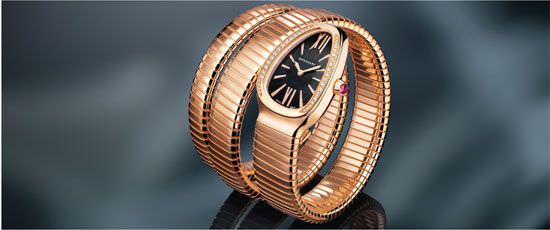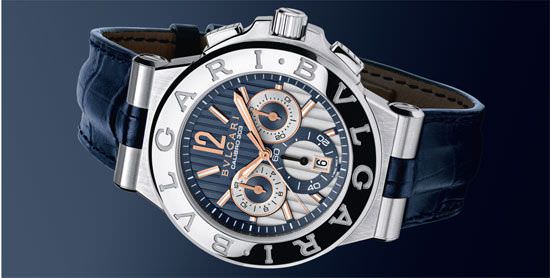
Europa Star: In a watchmaking landscape that is seeing a shuffling of cards (economic crisis, the announcement by Nicolas Hayek that the Swatch Group is stopping distribution of component parts), what is Bulgari’s strategy in terms of products? Do you envision stabilization, a move upmarket, or new and larger collections?
Francesco Trapani: Bulgari’s watch activities have considerably evolved over the last few years as we have crossed a number of important points. In the 1990s, watches were our main growth sector in comparison to other activities, and they enjoyed a lot of success. But times are changing; the environment is transforming; and our clients’ tastes and expectations are evolving. As a result, our watchmaking activities have also changed. At the beginning of 2000, Bulgari decided to move in the direction of adapting to the new parameters governing the watch industry and market. This reorientation called for a move towards the haut de gamme and haute horlogerie sectors.
Although Bulgari was primarily present in the quartz watch sector earlier, we chose to move into the high quality mechanical watch segment, which meant that we had to rethink the structure of our collections. We have gradually cleaned out the models in our entry-level assortment. As you know, this type of process requires an enormous amount of time because it has a major impact on the entire collection and positioning. I can say that, today, Bulgari is at the end of this process. Now, the brand’s watch pursuits are on a healthy base, at the end of a long line of efforts in repositioning our timepieces. Our goal is to have a much more marked presence in the domain of haute horlogerie.
More globally, our product strategy is based on two categories: Sophisticated men’s watches equipped with complicated movements; and collections intended for our feminine clientele, emphasizing how precious the pieces are. In this segment, we are putting a strong accent on the exclusive ladies’ collections such as Serpenti or Assioma D, for example, rather than simply reducing the size of our men’s watches like we were able to do in the past.
ES: From a stylistic point of view, are you leaning more towards a return to classicism or towards a definite rupture with your earlier designs?
FT: Before I answer your question, I would first like to say that one of the founding and core values of Bulgari resides in its creative history in terms of design. We have always differentiated ourselves, as much in our primary business—jewellery—as in watches where we have been active for the last 30 years, by an aesthetic creativity that is, in a certain way, our ‘brand label’. The Bulgari style is strongly identifiable. It is part of what we call our DNA. Our sources of inspiration are often and regularly drawn from the universe of antiquity and its stylistic values, but we reinterpret them with a contemporary vision and approach.
To come back to your question, this explains why Bulgari is not returning to classicism or making a break with our own designs. We remain what we are, Bulgari, with our own style and—if I may say so—a style that is unlike any other. We are lucky, given the richness of our history and the strength of our brand, to be able to remain ourselves without giving in to the stylistic trends of the moment.
ES: Do you think that you will follow your policy of integrating your production or will you continue to use sub-contractors?
FT: Your question relates to a larger topic that has been the subject of many discussions over the last few years, right up until recently. As mentioned in my answer to your first question, Bulgari started nearly ten years ago to reflect on its overall watch strategy. In parallel to reorienting the structure of the collections, we have begun a process of verticalization and integration that involves the acquisition of companies active in the manufacturing of major haut de gamme watch components: cases (Finger), dials (Cadrans Design) and bracelets (Prestige d’Or).
At the same time, we have always maintained loyal relationships with our sub-contractors with whom we deal for specific components, and we will continue to do so. The essential for us, through these successive acquisitions, resides in the mastery of watchmaking savoir-faire in the domain of cases rather than in needing to have 100 per cent verticalization down to the last screw.

SERPENTI
ES: Will you now speed up the development of specific in-house movements?
FT: Two years ago, we started to develop our own basic mechanical calibre at our sites in La Chaux-de-Fonds and Neuchâtel, which is a natural step for a brand active in prestige timekeeping and for any company determined to master the overall aspects of watchmaking from A to Z. This determination goes along with the various acquisitions that I mentioned earlier in the domain of the cases. This process will be finished this year, and it will allow us to complete our global knowledge in the domain of the mechanical calibre. Our image has thus logically become more consistent over the years in parallel with the major repositioning that we have done over the last decade.
I am convinced that this decision was the best one. We can thus say from this point of view that Bulgari is, going forward, a true watchmaking manufacture in the sense that we produce our own movements, cases, dials and bracelets. I do want to emphasize, however, that by ‘manufacture’, which is an over-used term, I do not mean to imply that Bulgari wants to produce all of its movements, cases and bracelets in-house! Our goal was and remains to master the savoir-faire for a portion of our collection—the high-end and the very high-end. As I said earlier, we will continue to depend upon our suppliers, with whom we have good relationships, for some of these various components.

DIAGONO 303
ES: Concerning distribution, how is it balanced between your own boutiques and your retailer networks?
FT: Bulgari has a strong international distribution network that allows us to be active on several levels and to ensure an optimal presence on a global scale in keeping with the reputation of the brand. This is explained naturally by the fact that we are a group in the luxury sector with a large number of products, notably jewellery, watches, perfume and accessories. Bulgari has more than 270 boutiques around the world and also distributes its products through a large network of agents and retailers. In all, we have a network of more than 700 points of sale. Our distri-bution channels are thus very well balanced between our own stores and our agents and retailers.
ES: People are asking a lot of questions about the future of Roth and Genta. Just what is the situation with these two watch brands?
FT: As you know, Bulgari has made great changes to its watchmaking pole. Up to the end of 2009, the group owned a portfolio of three distinct watch brands: Bulgari, Daniel Roth and Gérald Genta, attached to the manufacture of the same name. These two brands have benefited from total independence in relation to the group. We have, however, taken the decision to integrate their activities. In other words, we are placing their advanced savoir-faire under the Bulgari ‘umbrella’.
This does not mean a pure and simple integration, however. While no watches will be sold under the specific names of Roth or Genta, their mention will endure in reference to their specific manufacturing savoir-faire for which they are generally known. And, their names will figure on the dials of certain appropriate collections. They will become an integral part of Bulgari. To sum it up, the Bulgari brand now has a watch portfolio composed of three collections: Bulgari, Bulgari Roth, and Bulgari Genta. Each will have its own specifications and positioning, with a range of complications going right up to the grand sonnerie. The first products should reach the market sometime next autumn.
ES: What were the reasons behind this decision?
FT: The reasons that guided our decision are simple. Small niche brands are becoming more and more numerous in the marketplace. Without a strong base in terms of both finance and distribution, the situation is and will remain very difficult for them. This is why we decided to integrate Roth and Genta into our group structure, since the group is large enough to withstand economic downturns, and then rebound when the recovery begins. This also allows us to strengthen the Bulgari brand and to continue our move upmarket while maintaining the production tool of Genta and Roth intact.
It is also important to note that the production sites in the Vallée de Joux, in Sentier to be precise, will continue their activities. There will be no repercussions for the some 70 employees that work there. All three collections will benefit from the knowledge, the skills and the excellence of Roth and Genta, which will continue to deliver their own movements to the three previously cited collections. We will thus have movements from the Manufacture Roth & Genta in Sentier, in parallel to our own movement from the Bulgari manufacture that we have totally designed, developed, and produced in-house. It will be launched this year, as well as movements made by external suppliers.
Source: Europa Star April - May 2010 Magazine Issue




